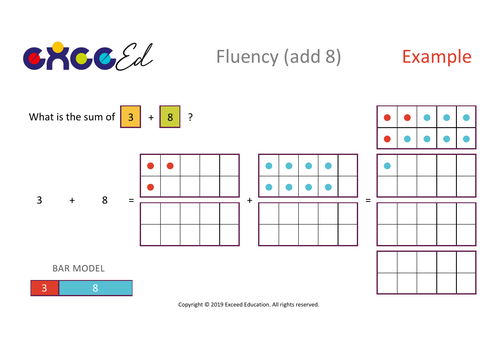
Do you operate a ‘mastery’ classroom? Do you find it difficult to teach bridging method using visual resources? Look no further than the full set of fluency activities designed to allow children to develop the skills of bridging as an addition strategy using Numicon or Tens Frames.
The full sets include blank spaces for children to record, an answer pack for demonstrating on the IWB, and an example question to start the teaching. Each set is divided into a specific addition focus (either adding 6, 7, 8, 9, 16, 17, 18, or 19).
This activity is ideal for children in Key Stage 1 or 2.
How could I use this activity?
Our staff have used these fluency packs in two main ways:
- As a whole class teaching input, using the Example page to show strategy of partitioning the add focus visually, followed by whole class work through of the questions whilst on the Interactive Whiteboard.
- Individual booklets (printing 4 pages per sheet in the print settings) and allowing children to work through the booklet with at their own pace, or with a teacher or TA).
How are the activities useful?
In terms of developing real mastery amongst your students, it is important that they can:
- Answer simple addition problems quickly from memory, or by using calculation strategies rather than counting. This pack allows children to develop a long term memory of addition facts through the visual nature, whilst helping them to calculate through a bridging strategy.
- Manipulate numbers in different ways so that they can be confident in any addition scenario. This pack enables children to consider the most efficient methods of bridging.
How do children develop more efficient methods?
Encourage your children to recognise the different ways to manipulate the calculation. As an example, consider 6 + 7:
- Some children will automatically change this to 7 + 6 because they have been drilled into “put the largest number first”. For true mastery, children must be able to recognise that addition involves the sum of two addends, and therefore it doesn’t matter which one goes first. So, how do we teach this? Ask them to calculate (not count) the answer both ways around. What do they notice?
- For 6 + 7, we partition 7 into 4 and 3, because 6 + 4 = 10, and this is what we call bridging.
- For 7 + 6, we partition 6 into 3 and 3, because 7 + 3 = 10.
- In both examples the sum is still 13, but the partitions we created we different.
So, which one is more efficient?
The honest answer is, once we are fluent, they are both efficient. But, whilst we are still learning, most children will find it easier to do 6 + (4 + 3) for the simple reason that even numbers bonds to 10 are easier to remember. Your biggest challenge as a teacher using a mastery style, is to get the children to recognise this of their own accord through real reasoning in the classroom. That’s why these resources have been designed to visually show each calculation.
Something went wrong, please try again later.
This resource hasn't been reviewed yet
To ensure quality for our reviews, only customers who have purchased this resource can review it
Report this resourceto let us know if it violates our terms and conditions.
Our customer service team will review your report and will be in touch.
